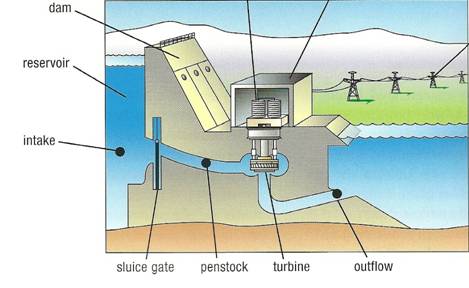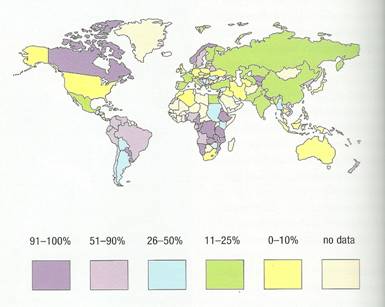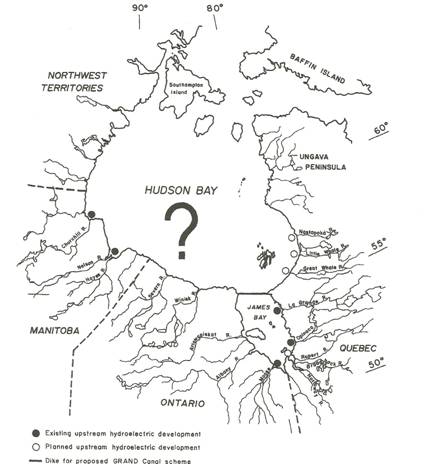Geology and Natural Heritage of the Long Valley Caldera
H2Oh! The Effects of Hydroelectric Power Production on the Environment in the Western US
Blair Dietrick
“Ocean and river currents contain a huge amount of energy. The question has always been: How can we get it without destroying the environment?”
-Alexander Gorlov, Alternative Energy SourcesAbstract
This paper describes the results of research conducted on hydroelectric power production. It considers the history and technicalities of hydropower, compares hydropower to other types of power, and examines its environmental impacts. In order to achieve this, a variety of sources have been referenced, looking at each side of hydropower: its basics, the business side, and various costs and benefits. Results showed hydropower to be a valuable source of power generation with a history of landscape destruction but the capacity to be the most environmentally friendly power source in the world. The benefits of hydroelectric power as a clean energy source are well worth the environmental costs it may inflict.
Introduction
What is hydropower?
Hydropower is power created using fresh water, usually from rivers. Hydroelectric power is electricity created by using water to turn the blades of turbines. Water provides direct kinetic energy by twisting the blades, which are connected to power generators (Spilsbury and Spilsbury, 2008).How It Works
Hydropower can be created through several different methods. Some hydropower plants use the run-of-river technique, which harnesses the natural flow of rivers (Spilsbury and Spilsbury, 2008). These are mostly smaller plants, called microhydro. However, most hydropower uses reservoirs of water stored in dams (see figure below). The water is then released through a sluice gate, and then turns a turbine (Spilsbury and Spilsbury, 2008).
Figure 1. Diagram of hydroelectric dam. Reproduced from Spilsbury and Spilsbury (2008).
Both dams and run-of-river systems use turbines (see figure below). Inside each turbine there is a shaft, which is attached to a generator. Water turns the rotor of the turbine. There are wire coils made of copper that move inside a circular strata of magnets when the rotor turns. This creates electrons when the wire coils pass the magnets, and the flow of these electrons is electricity. The generator is attached to transformers so that the electricity can be transmitted through cables over distances. All the utilities that are connected to these cables form the electric grid of the power plant (Spilsbury and Spilsbury, 2008).
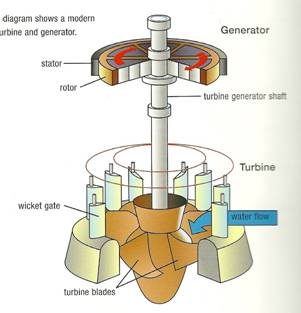
Figure 2. Diagram of hydroelectric turbine. Reproduced from Spilsbury and Spilsbury (2008).The History of Water Power
Using water for power is not a new idea. 4,000 years ago the Greeks used water to turn wheels to grind wheat into flour and the Chinese used water powered bellows (Spilsbury and Spilsbury, 2008). Water has been used in a variety of power-producing capacities throughout history, including pumps, waterwheels, clocks, and saws. In fact, water was used to run most machines until the invention of steam power in the early 19th century (Spilsbury and Spilsbury, 2008).Water was first used to generate electricity in the 1880s, when generators were fixed to waterwheels for the first time (Spilsbury and Spilsbury, 2008). On September 30th of 1882, H.F. Rogers created electricity with the first commercial hydroelectric plant in the world, using a dam on Fox River in Appleton, Wisconsin (Davis, 2006). Hydroelectric power quickly established itself as an important power source, and by 1940, 40% of all electricity in the US was generated by waterpower. However, following WWII most new power systems were developed to use with fossil and nuclear fuels (Spilsbury and Spilsbury, 2008).
In the late 20th century, waterpower resurfaced as an important energy source when innovators began to experiment with harnessing the enormous power of the ocean waves and tides for hydroelectric power (Spilsbury and Spilsbury, 2008).The History of Water Power Regulation
“This subject becomes political… And this subject is little known.”
-Jose Domingos Gonzalez Miguez, head of the climate sector of the Ministry of Science and Technology (MCT) of Brazil, Greenhouse Gas Emissions From Hydroelectric DamsMost of the hydroelectric generation capacity in the US is controlled by one firm- the Bonneville Power Administration, or the BPA. This firm is, in actuality, a manifestation of the US government (Bushnell, 1998). Therefore most of the hydroelectric power in the US is government-owned.
Those few dams that are nonfederal, are regulated by the Federal Energy Regulatory Commission, or the FERC (Echeverria et al., 1989). Traditionally the FERC turned down most propositions for new dams. However, the Public Utility Regulatory Policies Act of 1978 drastically changed the way proposals were processed. The PURPA act accelerated the development of ‘clean’ energy and led the FERC to approve the construction of thousands of new dams (Echeverria et al., 1989).
There are still very few large-scale nonfederal hydroelectric projects, since large-scale dams are very expensive to construct (Spilsbury and Spilsbury, 2008). Therefore the electricity market, almost entirely controlled by the BPA, is highly deregulated (Bushnell, 1998) and there are often large gaps between what the public wants in terms of water power and what is actually occurring. Public support for environmental conservation is now higher than ever, but hydroelectric projects continue to be built in ways that cause environmental destruction (Rosenberg and Usher, 1985). Most of the problems that arise in regard to water power are problems relating to how they are regulated; they are problems “of jurisdiction and unfulfilled responsibilities (Rosenberg and Usher, 1985)” because, in many cases, these is insufficient lawmaking and regulatory practice to guide those endeavoring to use hydropower (Kahrl, 1982).
California’s Role
Most of the hydroelectric generation capacity in the US is located in the Pacific Northwest and California (Bushnell, 1998). In fact, hydropower plays such an important role in California’s history that Kahrl (1982) goes so far as to say that “the history of California in the twentieth century is the story of a state inventing itself with water.” He continues to posit that “the modern prosperity of the state has consequently been founded upon a massive rearrangement of the natural environment through public water development.” Hydropower, therefore, plays an important role in California’s modern economy.Changes in Water Power
Most, if not all, of those against waterpower are primarily concerned with environmental harm caused by dams. Scientist Alexander Gorlov has developed a new turbine which would render these grievances immaterial by removing the need for dams altogether (Davis, 2006). The Gorlov Helical Turbine has the potential to “turn hydroelectric power into one of the most… environmentally benign renewable energy sources on the planet (Davis, 2006).” The Gorlov Helical Turbine would only use the energy of moving water, using hydrokinetic energy to create free-flow water power (Davis, 2006).With advances in waterpower technology reducing or eliminating the negative environmental effects of dams, waterpower is now becoming a more viable option for the future of power production.
Current Water Power
One fifth of electricity worldwide is generated using water energy, mostly hydropower. The largest reservoirs and dams can be seen from space (Spilsbury and Spilsbury, 2008). However, waterpower is no longer a significant contributor to power in the United States. As seen in figure 3 below, the United States uses only 7% hydropower- but the actual amount of hydropower is comparable to that of other countries. The percentage is low because the United States uses a disproportionately large amount of energy in general (Spilsbury and Spilsbury, 2008).
.
Figure 3. Percentages of hydropower worldwide. Reproduced from Spilsbury and Spilsbury (2008).600,000 miles of rivers in the US are currently being dammed (Echeverria et al., 1989). There are anywhere between 68,000 and 80,000 dams in total, which accounts for 17% of the 3.5 million miles of natural rivers in the US (Echeverria et a., 1989). Many have raised concerns that the amount of rivers being conserved is far too low- for each mile of river that is preserved, another 65 miles have been dammed (Echeverria et al., 1989).
Comparing Hydroelectric Power to Other Power SourcesComparing Renewable and Nonrenewable Resources
Although power from ‘new’ energy is often more expensive than fossil fuels (Spilsbury and Spilsbury, 2008), there is a general public consensus that ‘clean’ energy (wind, water, geothermal) is more desirable than fossil fuels because renewables are “in endless supply” (Spilsbury and Spilsbury, 2008) and will not harm the environment. Though these claims are not entirely true, it certainly is true that nonrenewable resources are better for the environment than fossil fuels.Emergy
Emergy is a term used to comprehensively measure the amount of energy needed to produce something. Emergy is the amount of available energy of one kind that is required to make something, and that is used up in the transformation process (Brown and Ulgiati, 2002). It measures the global processes needed to produce something. Therefore, the more work needed to produce something, the higher the emergy value of the product. This is called emergy valuation (Brown and Ulgiati, 2002).
Emergy valuation is beneficial because it measures both the thermodynamic and the environmental values of energy and material resources, thereby painting a truer picture of the effects production has on many different levels, and placing those effects within a common framework (Brown and Ulgiati, 2002).Within the categories of renewable and nonrenewable resources, emergy index results are very similar. Using an emergy index of sustainability, it can be quantitatively proven that renewable energy source plants like wind, hydroelectric, and geothermal had higher sustainability compared to thermal plants, as would be expected (Brown and Ulgiati, 2002). These indices are shown below in Figure 4.
Environmental Loading
Environmental loading is a term used to refer to the “load” exerted on the environment when a process requires environmental services. It is also the concept that, once an environmental service is used by one process, it is not then available for use by another process (Brown and Ulgiati, 2002). Just as with emergy, it can also be quantitatively proven that renewable energy systems have lower environmental loading than nonrenewable energy systems (Brown and Ulgiati, 2002).
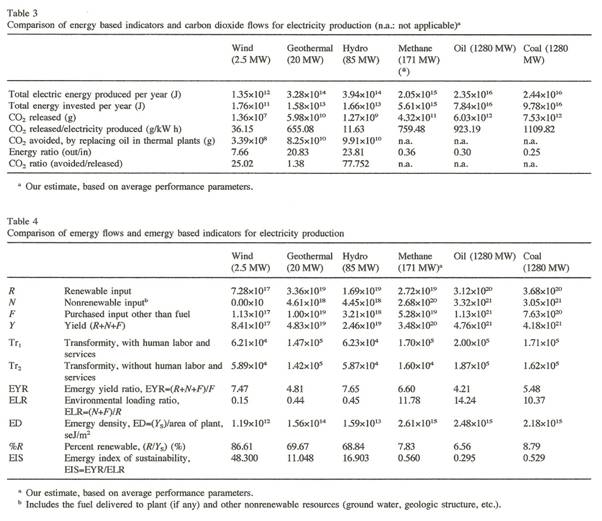
Figure 4. Emergy indices for different energy sources. Reproduced from Brown and Ulgiati (2002).Comparing Different Renewables
As previously mentioned, the emergy and environmental loading results within the category of nonrenewable resources are very similar. However, the differences, small though they may be, show which of the renewables are the most sustainable.As can be seen on the chart above, wind, geothermal, and hydro plants have the highest percent renewable inputs. Wind power has the highest renewability, followed by hydropower, then geothermal. Geothermal plants have high renewability but that renewability is coupled with high C02 release, much higher than wind or thermal and comparable to that of fossil fuel plants (Brown and Ulgiati, 2002). Additionally, geothermal plants may leave a larger and more long-lasting mark on the environment than wind or hydro power- at one plant in California, the hydrologic monitoring program on a plant found that geothermal development was causing changes in the hydraulic system as well as variations in precipitation and recharge (Class Binder, 2010). Plants should not be assessed just for their emissions, but also for their effects on the biosphere (Brown and Ulgiati, 2002).
Wind and hydropower plants also demanded less than half the amount of environmental support other plants required, demonstrating a lower pressure on the land. Wind and hydroelectric plants had the highest-over-all aggregated- that is to say, economic and ecological- sustainability, followed by geothermal electricity (Brown and Ulgiati, 333).
The Costs and Benefits of Water Power
Benefits
Once the high initial costs of construction are over, the actual operating costs of running a waterpower facility are very low- one quarter the price of operating a coal plant, and half the price of nuclear. In fact, hydropower is the cheapest way to generate power with today’s technology (Spilsbury and Spilsbury, 2008). In addition to its cheapness, water power is also very reliable, making it an excellent baseload power source- meaning that it can provide the energy needed all the time, not just during high demand periods such as intervals of very hot or very cold weather (Spilsbury and Spilsbury, 2008). Also, as mentioned above, hydropower is one of the most environmentally friendly forms of power production. However, it may be that hydropower gains its advocates not because of its good qualities, but simply because it is good in comparison to other power sources. In light of other energy crises, hydropower becomes a “benign bargain (Palmer, 2006).”Costs
Hydropower has many advocates, but it also has many adversaries, who cite the “hidden costs of hydropower” and claim that the apparent benefits are merely a part of the “myth of hydropower (Palmer, 2006).”
The supposed costs of hydropower are varied and include negative effects on riparian zones, landscape destruction, and the release of greenhouse gases.Riparian Zones
Riparian Protection
Riparian zones cover less than 1% of the landscape of the western US, but they provide valuable habitats for many species of breeding birds (Knopf et al., 1998). The importance of riparian zones as animal habitats is recognized by the government. The Bureau of Land Management has four basic policies in regard to riparian ecosystems: to avoid adverse impacts on riparian areas when possible, to avoid new construction in riparian areas where a practical alternative is available, to preserve and enhance riparian sites and regulate those uses which would cause irreparable damage, and to minimize actions causing definable adverse impacts (Knopf et a., 1998). However, these guidelines are very basic and riparian zones are under the jurisdiction of multiple governmental departments.
Specific written policies on riparian conservation have not been developed in the US Department of Agriculture’s Soil Conservation Service, despite numerous projects that have affected the conservation of riparian vegetation (Knopf et al., 1998).The Bureau of Reclamation conducts projects designed to develop water resources in compliance with federal mandates, and the agency participates in riparian habitat and species management programs. However, BOR guidelines do not specifically address riparian or wildlife issues (Knopf et al., 1998).
The commonality throughout these departments is vague guidelines ensuring the protection and conservation of riparian zones, but a lack of specific attention and regulation.
Effects of Hydropower on Riparian Zones
Despite all the concern about effects that stream diversion for hydropower will have on riparian zones, in reality, the influence of diversion on riparian zones is not significant (Harris et al., 1987). The only impacts attributed to diversion as found by Harris et al. (1987) were increased shrub cover and decreased vegetated channel width, and diversion effects were not significant for any of the vegetation variables. Variability in results, as can be seen in Figure 5 below, impairs the possibility of generalization about vegetative responses- none of the results were consistent between different riparian zones studied, leading Harris et al. (1987) to conclude that riparian communities in the Sierra Nevada respond in an individualistic manner to hydroelectric diversions.
Figure 5. Effects of diversion on riparian streams. Reproduced from Harris et al. (1987).Landscape Destruction
Hydroelectric power production can cause landscape destruction with redirected power- that is, power not used by the plant that is then unleashed on the surrounding landscape (Rosenberg and Usher, 1995).Landscape destruction comes in many different forms- flooded reservoirs, river diversions, riverbank erosion, “dead zones” surrounding reservoirs due to drawdown, and far-reaching effects such as changes to ecosystems downstream of hydro plants, marked departure from past flows, long term reduction in summer and peak flows (which can cause wetlands to dry up), reduction of animal populations, reduced spawning success of fish, and 50-55% decrease in shorelines (Rosenberg and Usher, 1995). There could also be a reduction of soil fertility, and some scientists believe that big reservoirs can cause earthquakes as the weight of water pressing on rock weakens the earth’s crust (Spilsbury and Spilsbury, 2008). This is known as reservoir induced seismicity.
This destruction can occur quickly- the Owens Lake completely dried up in just 11 years when the Los Angeles Department of Water and Power expanded groundwater pumping (Hill, 1975).
The results of hydroelectric development are somewhat unique to specific projects; landscape destruction differs depending on the types of landforms involved (Rosenberg and Usher, 1995).
There is a lot of uncertainty surrounding the effects of hydropower development downstream of the project. These areas are often out of the jurisdiction of the agency responsible for the project, and there is a general lack of interest in pursuing post-audits of major projects due to their high costs and complexity (Rosenberg and Usher, 1995). As seen in Figure 6 below, much of the research going into the effects of hydropower development is guesswork at best.
Figure 6. Predicted effects of Hudson Bay hydroelectric project. Reproduced from Rosenberg and Usher (1995).Greenhouse Gases
The release of greenhouse gases as a result of hydropower production is the newest “surprise” connected with reservoir creation (Rosenberg and Usher, 1995). The gases are released by microbial decomposition when upland forests and peatlands are flooded in the course of reservoir creation. Natural balances are upset by the flooding and the flux of greenhouse gases to the atmosphere increases. In fact, rate of emission after flooding may be similar to that of power plants run by fossil fuels (Rosenberg and Usher, 1995). Carbon dioxide emissions are highest during the first several years after filling a reservoir. Based on these first few years alone, any weighing of emissions impacts would favor fossil fuel alternatives over hydraulic generation (Fearnside, 2004).
Both the methane emitted from turbines and spillways and the carbon dioxide from above-water decay of standing trees contribute to emissions and pollution (Fearnside, 2004). Reservoirs can become virtual methane factories as the rise and fall of reservoirs flood and submerge land around the shore, causing vegetation to grow quickly then decompose when reservoirs rises again, which converts atmospheric carbon dioxide into methane (Fearnside, 2004).
Mercury also contaminates fish. Mercury has been found in fish many kilometers downstream of reservoirs in Canada, meaning these fish can carry the mercury to ecosystems otherwise out of reach of the dams themselves (Rosenberg and Usher, 1995). Reservoirs are now recognized as a leading cause of mercury contamination of fish (Rosenberg and Usher, 1995).
Rosenberg and Usher (1995) say that there is still a great deal of uncertainty surrounding hydroelectric development, and that some of the major impacts of hydroelectric development are still being identified.The Issue of Values
The main issue surrounding hydropower may be that of values. The values of decision makers tend to differ from those of people concerned with environmental conservation. Although information about the adverse effects of waterpower is readily available, projects continue as before, without beneficial changes being implemented. For large-scale hydroelectric projects to make sense, water resources like rivers and lakes in their natural state would have to be regarded as having no monetary value (Rosenberg and Usher, 1995). Rosenberg and Usher (1995) assert that the attitude that these hydrological resources are wasted if they are allowed to exist in their natural state, and are not harnessed for industrial use, is commonplace.
This seems to be the case. The BPA places high value on being able to reduce its minimum flow requirements in June, the month when they are at their highest (Bushnell, 1998), despite the fact that these requirements are set in place in order to ensure the health of rivers and the fish and animals living in them.
The Electric Consumers Protection Act (ECPA) was created to change existing law that gave preference to power development, so that power development and the preservation of rivers would be giver equal consideration (Echeverria et al., 1989). However, if the rivers were valued for their natural benefits and uses, wouldn’t they be given more consideration than power development?Conclusion
Though hydroelectric power has traditionally caused some environmental harm, it is not substantial enough to warrant this source of power unusable. Due to changing lifestyles and standards of living worldwide, energy needs are predicted to rise 50% in the next 20 years (Spilsbury and Spilsbury, 2008). As the United States and the world search for ways to increase the amount of power accessible without increasing strains on the environment, hydroelectric power could become a major part of the future of power generation.The Future of Water Power
Controversies in hydropower production provide a springboard for reevaluating the impacts of hydroelectric dams, and the role they play in climate change (Fearnside, 2004). The issues currently being experienced- i.e. greenhouse gases and landscape destruction- are not necessarily deal breakers for hydroelectric power, but perhaps an opportunity for scientists and innovators to discover new and improved methods for an old process.
If lakes were used only within their natural ranges, shoreline erosion and flooding- two of the most destructive elements of hydroelectric development- could be avoided (Rosenberg and Usher, 1995).
If public land management agencies could develop specific procedural guidelines for addressing management of riparian zones (Knopf et al., 1998) and other natural hydro resources, hydroelectric plants could work with the natural environment to utilize its power, instead of against it.With the water resources available, there could be two to three times as much waterpower in the future as there is now (Spilsbury and Spilsbury, 2008). This added power can be harnessed from natural water sources or from pre-existing dams- only 3% of US dams are currently used for hydropower. These dams could be converted to include turbines and generators without much added cost (Spilsbury and Spilsbury, 2008).
Since dams are known to cause the most environmental harm of hydroelectric facilities, the biggest growth in the future will most likely be seen in wave, tidal, and microhydro installations (Spilsbury and Spilsbury, 2008). If the full power of hydropower was harnessed, use of fossil fuels could be cut drastically or eliminated. As Alexander Gorlov states in Alternative Energy Sources (2006), “The Gulf Stream (alone) contains enough energy for all of North America.” Hydropower could be the answer to questions about global warming, pollution, and sustainability- if it is used properly.Works Cited
Brown, M.T., and S. Ulgiati. "Emergy Evaluations and Environmental Loading of Electricity Production Systems." Journal of Cleaner Production 10.4 (2002): 321-34. ScienceDirect. Web. 1 June 2010. <http://bert.lib.indiana.edu:2202/science?_ob=ArticleURL&_udi=B6VFX-45B5NKW-4&_user=1105409&_coverDate=08%2F31%2F2002&_rdoc=1&_fmt=high&_orig=search&_sort=d&_docanchor=&view=c&_searchStrId=1358000666&_rerunOrigin=scholar.google&_acct=C000051666&_version=1&_urlVersion=0&_userid=1105409&md5=ed5352131dd332fb95e3aa22cd2f41c1#toc4>.
Bushnell, James. "Water and Power: Hydroelectric Resources in the Era of Competition in the Western US." University of California Energy Institute (1998): 1-34. Berkeley.edu. Web. 2 June 2010. <http://www.ucei.berkeley.edu/PDF/pwp056.pdf>.
Davis, Jill. "Advances in Hydropower Technology Can Protect the Environment." Alternative Energy Sources. Detroit: Greenhaven, 2006. 82-87. Print.
Echeverria, John D., Pope Barrow, and Richard Roos-Collins. Rivers at Risk: the Concerned Citizen's Guide to Hydropower. Washington, D.C.: Island, 1989. Print.
Fearnside, Philip M. "Greenhouse Gas Emissions From Hydroelectric Dams: Controversies Provide A Springboard For Rethinking A Supposedly ‘Clean’ Energy Source." Climactic Change 66.1-2 (2004): 1-8. SpringerLink. Springer Netherlands, 26 Oct. 2004. Web. 1 June 2010. <http://bert.lib.indiana.edu:2146/content/l8381013770378v5/>.
Geothermal Power, Indiana University Sierra Trip 2010 Binder
Harris, Richard R., Carl A. Fox, and Roland Risser. "Impacts of Hydroelectric Development on Riparian Vegetation in the Sierra Nevada Region, California, USA." Environmental Management 11.4 (1987): 519-27. Web. 7 June 2010. <http://bert.lib.indiana.edu:2146/content/n546q3863563002r/>.
Hill, Mary. "Chapter 11: Mono Lake: The "Dead Sea" of the West." Geology of the Sierra Nevada. Berkeley: University of California, 1975. Print.
Hydrologic Studies in Long Valley Caldera, Indiana University Sierra Trip 2010 Binder, USGS website, http://lvo.wr.usgs.gov/HydroStudies.html, accessed 23 April 2004
Kahrl, William L. Water and Power: the Conflict over Los Angeles' Water Supply in the Owens Valley. Berkeley: University of California, 1982. Google Scholar. Web. 1 June 2010. <http://books.google.com/books?hl=en&lr=&id=DH_hxwAD_2UC&oi=fnd&pg=PR7&dq=hydroelectric+power+owens+valley&ots=SLID7RsaAf&sig=J3d5ZgXvaqtjh8n-BEwtw65Qe7w#v=onepage&q=hydroelectric%20power%20owens%20valley&f=false>.
Knopf, Fritz L., R. Roy Johnson, Terrell Rich, Fred B. Samson, and Robert C. Szaro. "Conservation of Riparian Ecosystems in the United States." The Wilson Bulletin 100.2 (1998): 272-84. JSTOR. Wilson Ornithological Society. Web. 2 June 2010. <http://www.jstor.org/stable/4162566>.
Palmer, Tim. "Damming Rivers for Hydroelectric Power Harms the Environment." Alternative Energy Sources. Detroit: Greenhaven, 2006. 97-102. Print.
Rosenberg, D M, R A Bodaly, and P J Usher. "Environmental and Social Impacts of Large Scale Hydro-electric Development: Who Is Listening?" Global Environmental Change 5.2 (1995): 127-48. JSTOR. Web. 1 June 2010. <http://bert.lib.indiana.edu:2202/science?_ob=ArticleURL&_udi=B6VFV-3YVCYS1-G&_user=1105409&_coverDate=05%2F31%2F1995&_rdoc=1&_fmt=high&_orig=search&_sort=d&_docanchor=&view=c&_searchStrId=1356920881&_rerunOrigin=scholar.google&_acct=C000051666&_version=1&_urlVersion=0&_userid=1105409&md5=049c9782f119963173d62f6be54f6685>.
Spilsbury, Richard, and Louise Spilsbury. The Pros and Cons of Water Power. New York: Rosen Central, 2008. Print.
